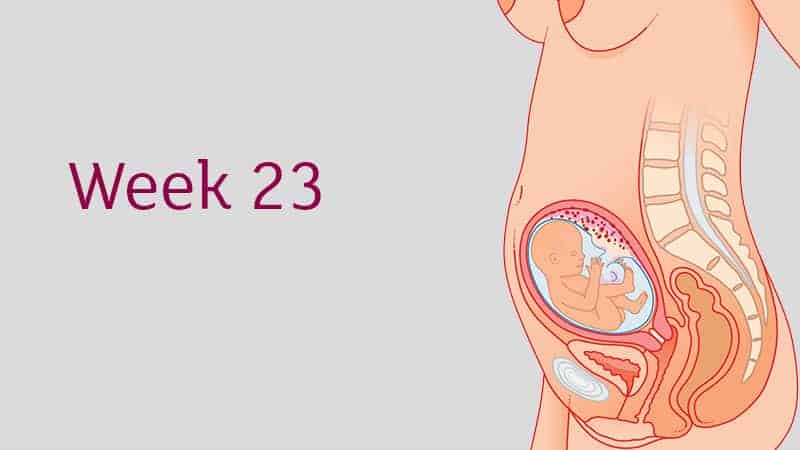
Table of Contents
You are almost halfway through your pregnancy on the 23rd week and your body is getting prepped up for lactation at the same time your baby has started developing their lungs. Your baby is 11.4 inches long and weighs 1.1 pounds on the 23rd week of pregnancy.
Want to know about 23 weeks pregnant belly? Well, At 23 weeks pregnant, your belly is likely to be noticeably round and more pronounced. The size of your belly can vary based on your body type, the position of the baby, and whether it’s your first pregnancy or not. On average, at 23 weeks, your uterus is about 1.5 to 2 inches above your belly button.
Although, it is important to note that every pregnancy is unique, so the size and shape of your belly can differ from others. If you have concerns about the size of your belly or your overall pregnancy progress, it’s best to consult with your healthcare provider. They can assess your individual situation and provide personalized guidance based on your specific needs.
So what else is happening to the baby in the 23 weeks of pregnancy?
Your baby is still translucent at 23 weeks—but that’s beginning to transform as soon as it starts to build muscle.
Here’s what is happening to a mother’s body in the 23rd week of pregnancy-
1. Breathing practice
Blood vessels in the lungs of the baby are forming to assist them to breathe. (While they are in the uterus, they are breathing amniotic fluids.)
2. Vital development
Your baby will develop extremely quickly in the next month, doubling its weight in just four weeks by receiving approximately six ounces each week.
3. Strong heartbeat
When you’re 23 weeks pregnant, your child’s heartbeat is so strong that you can hear it via a stethoscope.
What happens to a mother’s body in the 23rd week of pregnancy?
From dripping breasts to trembling to a continuous necessity to urinate, you might have a ton going on at the moment! Here’s the rundown of some of what you might experience when you’re pregnant for 23 weeks.
1. Leaky boobs
As your boobs shift from beauty to lactation, you can note a little colostrum or pre-milk leakage. (A few nursing pads might be extremely useful.)
2. Darker nipples
Your nipples can also begin to darken and pop out slightly. It’s perfectly natural. They’re going to revert to their lighter color once you start breastfeeding.
3. Swollen feet and ankles
Pregnant women prefer to hold water, which induces slight swelling. To cope with that too, pick your legs up when you sit down, switch positions frequently, and exercise daily. Even though it appears counter-intuitive, drink lots of fluids to reduce the chance of dehydration. Extreme or unexpected swelling is a reason for concern, as it can be a symptom of preeclampsia. Inform your healthcare professional if you are worried about this.
4. Strange cravings
Pregnant women are famed for their eating habits, but what if you’ve got a weird need for something that isn’t edible? Say that to your gynecologist! Non-food cravings may often be an indication of a disorder called pica. If you want something weird, like clay, mud, or cornstarch, it could be a signal of insufficient iron or other nutrient deficiencies. Your medical professional will examine you and support you so that you can go back to the cravings for hot chocolate.
5. Frequent bathroom breaks
Your child is developing rapidly to start placing weight on your bladder. It’s very normal to have to pee a lot or even leak a little.
6. Vaginal Discharge Is Normal
Don’t want to make it awkward, but often you need someone else to tell you what’s happening in your underpants. It is common to have a spike in vaginal discharge during pregnancy. (This is called leukorrhea.)
But there are a few things to watch out for:
- Fishy-smelling post-sex discharge: This is a symptom of bacterial vaginosis, a prevalent vaginal infection.
- Yellow-green, brown, green, pink-tinted, or yellow discharge: This could mean that you have an STD.
- Constant clear fluid: This may be the rupture of your amniotic sac. Uncertain if it’s a little bladder leaking or an amniotic fluid leakage? Generally, the amniotic fluid is odorless and occurs either in a squirt or a flow that doesn’t end. If you believe that this is an amnio, seek medical care instantly.
- Itchiness: It may be linked to bacterial vaginosis, yeast infection, or STD. Get it tested out.
All these problems can be dealt with, so call your doctor if you feel anything is going to happen.
What would your belly look like in the 23rd week of pregnancy?
Weight gain is supposed to stay constant at around a pound per week now and before you give birth.
Your baby will possibly give you small movements and kicks at 23 weeks. You might also see your whole belly shifting when they twirl over. That could be truly spectacular.
In Conclusion
Not decided on your baby shower guest list till now?
Well, it’s high time that you start planning on such things, for instance, your baby’s bag with all the essentials like wipes, clothes and spare cotton pads, and much more would need once they arrive.






